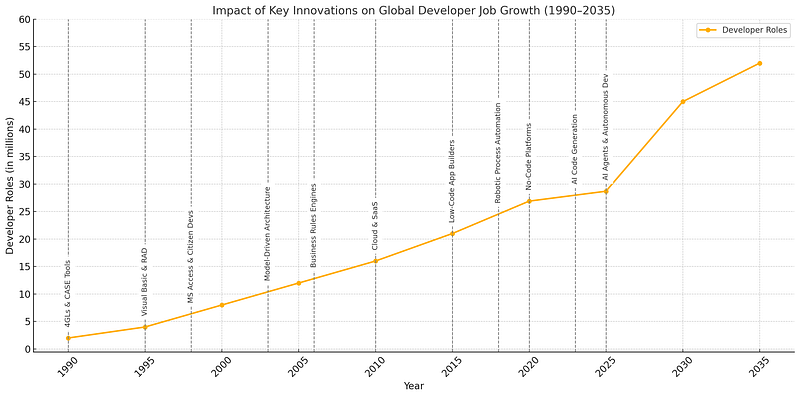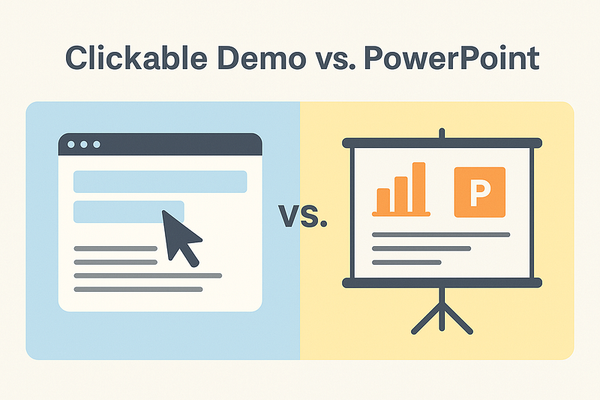The Developer Paradox: Why Technology Innovation and AI Keep Creating More Dev Jobs
Every few years, a new wave of innovation promises to reduce the need for software developers. But the opposite keeps happening…

While I started going gray in high school, most of the gray hair I have today was earned. It’s a testament to the hard lessons, long nights, and evolving tech I’ve lived through over the years. One of the biggest truths I’ve learned: advances in technology haven’t made developers obsolete — they’ve created more opportunities than ever before.
For decades, we’ve been told the same story: the next wave of development tools will reduce the need for software developers. I heard it in the early ’90s with ADA, then with Visual Basic, then Microsoft Access… and on it went. From the rise of visual tools to today’s generative AI, every innovation has promised more output with fewer people.
But the data tells a different story.
Despite enormous advances in productivity and automation, the number of software developers globally has not decreased. It’s grown… dramatically. According to industry reports and projections, developer roles have increased from fewer than 1 million in the 1980s to over 27 million in 2021. By 2035, we’re on track to reach 60 million.
The Pattern of Innovation
To dig deeper into this trend, I used ChatGPT to analyze and visualize the historical and projected growth of developer roles from 1990 through 2035.
Prompt: Gather historical and projected data on the global number of software developer-related jobs from 1990 to 2035 using credible sources. Focus on total global figures, but include regional data (e.g., U.S., Europe, Asia) if global numbers are unavailable.
I also asked ChatGPT to help me identify a timeline of key innovations that were introduced with the promise of reducing the need for developers.
Prompt: Identify key tech innovations/trends since 1990 that increased developer productivity or reduced the need for developers. For each, explain its impact and provide an approximate timeframe. Focus on tools, platforms, methodologies, and automation.
Here’s the short list of major innovations that aimed to make software development “easier,” “faster,” or “less dependent on developers”:
- 1990s: 4GLs and CASE Tools
- Mid-1990s: Visual Basic, Delphi, Rapid Application Development (RAD)
- Late-1990s: Microsoft Access, Citizen Developers
- 2000s: UML and Model-Driven Architecture
- 2010: Cloud and SaaS Platforms
- 2018: Robotic Process Automation (RPA)
- 2020: No-Code / Low-Code Platforms
- 2023: Generative AI, Copilot
- 2025 (projected): AI Agents & Autonomous Software Development
And yet… demand for developers kept rising.
To visualize this even more clearly, I had ChatGPT generate a chart overlaying these innovations against the growth curve.
Prompt:
Create a clean, professional line chart that visualizes the impact of software development related innovations on global growth in software developer-related jobs from 1990 through 2035, including a forward-looking projection beyond 2030.
Chart Specifications:
• X-Axis: Years (1990–2035), labeled in 5-year intervals
• Y-Axis: Global number of software developer roles (in millions), appropriately scaled
• Trend Line: Plot the actual and projected global software developer job growth
Overlay the innovations on the chart include clear visual markers and concise labels for the introduction or mainstream adoption of the following software engineering innovations
Guidelines: Use a subtle but distinct visual marker (e.g., dashed line, dot, or arrow) for each innovation. Position a short annotation above or near each marker with the name of the innovation. Annotations should not obstruct the main trend line and must remain easily readable
Why Does Demand Keep Rising?
Because every wave of innovation expands what’s possible… and that unlocks new complexity, new expectations, and new business models. The result? New demand for developers.
Each generation of tooling doesn’t eliminate developers. It shifts what they need to do:
- 4GLs and visual IDEs made it faster to build software, more software was built, which needed more developers to maintain
- Cloud & SaaS platforms abstracted infrastructure, so we needed more DevOps and backend engineers.
- No-code platforms empowered business users, but devs still build the APIs, governance layers, and data models.
- GenAI helps write code, but someone has to validate, refactor, and integrate it responsibly.
What This Means for Developers
If you’re a developer, you’re not at risk of being replaced… unless you refuse to evolve.
Adaptability is your competitive edge. The developers who thrive are the ones who:
- Learn to leverage new tools like Cursor.AI, not fear them
- Understand business context and collaborate cross-functionally
- Stay curious and invest in learning outside of work
If that’s not your mindset today, change it. The landscape is shifting fast… and the next generation of tools will reward those who move with it.
Side Note: Stating the Obvious…AI will have profound impact on research and analysis
I used ChatGPT to accelerate the research and creation process by:
- Pulling historical and projected global developer job data
- Identifying key productivity innovations since 1990
- Generating a timeline and annotations
Total time: about 15 minutes. The outcome? A clear and compelling way to tell a story I’ve long believed, backed by data.
Final Thought
If you’re building tools for developers, stop talking about how you’ll “replace” them.
Developers are your users. Your advocates. Your community.
Build for them. Empower them. They’re not going anywhere.


